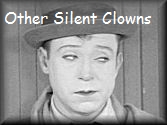EN COMPAGNIE DE MAX LINDER
(aka POP GOES THE CORK; LAUGH WITH MAX LINDER)
(1963)With Max Linder
Directed by Maud Linder
Silent, Black and White
Reviewed by JB
 Max Linder, who created one of film comedy's first popular
recurring characters, starred in over 200 films from 1906 to 1925.
An international superstar in the early days of the 20th
century, his influence on those who came after him was extensive
(Chaplin himself called Linder "The Professor") and yet, he is little
known or talked about today. One of movie history's tragic
figures, Max, along with his young wife, committed suicide in 1925 after
battling depression for several years. In 1963, his daughter Maud
put together EN COMPAGNIE DE MAX LINDER ("In The Company of Max
Linder"), later known under the title of POP GOES THE CORK or
LAUGH WITH MAX LINDER. In this film, Maud Linder presents footage
from three of Max Linder's late American features: SEVEN YEARS BAD
LUCK, BE MY WIFE (both 1921) and THE THREE
MUST-GET-THERES (1922).
Max Linder, who created one of film comedy's first popular
recurring characters, starred in over 200 films from 1906 to 1925.
An international superstar in the early days of the 20th
century, his influence on those who came after him was extensive
(Chaplin himself called Linder "The Professor") and yet, he is little
known or talked about today. One of movie history's tragic
figures, Max, along with his young wife, committed suicide in 1925 after
battling depression for several years. In 1963, his daughter Maud
put together EN COMPAGNIE DE MAX LINDER ("In The Company of Max
Linder"), later known under the title of POP GOES THE CORK or
LAUGH WITH MAX LINDER. In this film, Maud Linder presents footage
from three of Max Linder's late American features: SEVEN YEARS BAD
LUCK, BE MY WIFE (both 1921) and THE THREE
MUST-GET-THERES (1922).
BE MY WIFE, in which Max stages a fake burglary and heroic battle (with himself!) to impress his girl and potential mother-in-law, is edited together with SEVEN YEARS BAD LUCK, in which Max breaks his standing mirror and then worries about the bad luck that may follow. There is an attempt to create one long rambling story from the combined footage, but it makes little sense. However, that doesn't mean there aren't any laughs. The Max character was a sophisticated, suave and flirty man about town, perfectly capable of existing in polite society. Yet Linder had a great mind for cinematic gags and had no trouble getting his own character into all sorts of mischief. Case in point, the great mirror sequence from SEVEN YEARS BAD LUCK in which servants accidentally break a mirror and then trick Max into thinking one of them is his own reflection. According to Walter Kerr in his classic book The Silent Clowns, Linder may actually be the inventor of this often-borrowed gag, reprising it from a much earlier film. Even if it isn't his invention, few ever did it better.
There are good gags and sequences throughout the
whole compilation, although the Linder persona is so firmly established
in the first half that THE THREE MUST-GET-THERES, an almost Mel
Brooks-like parody of Douglas Fairbanks, feels like it comes from a
completely different comedian.
Historically, except for the mirror sequence, EN
COMPAGNIE DE MAX LINDER cannot be used to prove Linder's influence on
his fellow comedians, as the three films are from his later career,
after Chaplin, Keaton and Lloyd had already established themselves.
It is still a valuable documentary and a great introduction to a
comedy writer, performer and director who deserves to be better
known.  - JB
- JB


